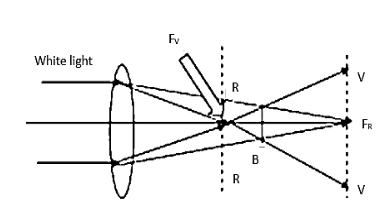Answer
393.9k+ views
Hint: An achromatic lens can be described as a lens which is created by the combination of two different kinds of lenses which are having different focal powers in a manner so that the images created by the light of both the combined lenses are free from chromatic aberration or otherwise known as achromatism. The equation for the condition of achromatism is,
$\dfrac{{{\omega }_{1}}}{{{f}_{1}}}+\dfrac{{{\omega }_{2}}}{{{f}_{2}}}=0$
Using this equation, we can find out the relation between the dispersive powers of both the lenses.
Complete answer:
For the achromatic combination of lenses, the condition of achromatism is given by the equation,
$\dfrac{{{\omega }_{1}}}{{{f}_{1}}}+\dfrac{{{\omega }_{2}}}{{{f}_{2}}}=0$
As per the question, it is already mentioned that the dispersive powers of the lenses are $\omega$ and ${\omega }'$ and the focal length of the lenses are given as $f$ and ${f}'$ respectively.
Substituting these in this equation will give,
$\dfrac{\omega }{f}+\dfrac{{{\omega }'}}{{{f}'}}=0$

Substitute the conditions given in each option in the equation,
\[\begin{align}
& \dfrac{{{\omega }_{0}}}{f}+\dfrac{2{{\omega }_{0}}}{{{f}'}}=0 \\
& \therefore {f}'=-2f \\
\end{align}\]
So, the correct answer is “Option D”.
Note:
An achromatic lens is basically a combination of convex and concave pieces of glass that focuses the different colour with different wavelengths in light into a single plane. Each kind of glass disperses each colour differently when put together, they will counterbalance each other and create a sharp image. Chromatic aberration is referred to the blurring or colouring of red, green, blue, yellow, purple, orange and so on, near the edges of an image. These colours usually seemed to appear in high-contrast photos with a lot of highlights and shadows.
$\dfrac{{{\omega }_{1}}}{{{f}_{1}}}+\dfrac{{{\omega }_{2}}}{{{f}_{2}}}=0$
Using this equation, we can find out the relation between the dispersive powers of both the lenses.
Complete answer:
For the achromatic combination of lenses, the condition of achromatism is given by the equation,
$\dfrac{{{\omega }_{1}}}{{{f}_{1}}}+\dfrac{{{\omega }_{2}}}{{{f}_{2}}}=0$
As per the question, it is already mentioned that the dispersive powers of the lenses are $\omega$ and ${\omega }'$ and the focal length of the lenses are given as $f$ and ${f}'$ respectively.
Substituting these in this equation will give,
$\dfrac{\omega }{f}+\dfrac{{{\omega }'}}{{{f}'}}=0$

Substitute the conditions given in each option in the equation,
\[\begin{align}
& \dfrac{{{\omega }_{0}}}{f}+\dfrac{2{{\omega }_{0}}}{{{f}'}}=0 \\
& \therefore {f}'=-2f \\
\end{align}\]
So, the correct answer is “Option D”.
Note:
An achromatic lens is basically a combination of convex and concave pieces of glass that focuses the different colour with different wavelengths in light into a single plane. Each kind of glass disperses each colour differently when put together, they will counterbalance each other and create a sharp image. Chromatic aberration is referred to the blurring or colouring of red, green, blue, yellow, purple, orange and so on, near the edges of an image. These colours usually seemed to appear in high-contrast photos with a lot of highlights and shadows.
Recently Updated Pages
Basicity of sulphurous acid and sulphuric acid are

Assertion The resistivity of a semiconductor increases class 13 physics CBSE

Three beakers labelled as A B and C each containing 25 mL of water were taken A small amount of NaOH anhydrous CuSO4 and NaCl were added to the beakers A B and C respectively It was observed that there was an increase in the temperature of the solutions contained in beakers A and B whereas in case of beaker C the temperature of the solution falls Which one of the following statements isarecorrect i In beakers A and B exothermic process has occurred ii In beakers A and B endothermic process has occurred iii In beaker C exothermic process has occurred iv In beaker C endothermic process has occurred

The branch of science which deals with nature and natural class 10 physics CBSE

What is the stopping potential when the metal with class 12 physics JEE_Main

The momentum of a photon is 2 times 10 16gm cmsec Its class 12 physics JEE_Main

Trending doubts
Difference Between Plant Cell and Animal Cell

Difference between Prokaryotic cell and Eukaryotic class 11 biology CBSE

Fill the blanks with the suitable prepositions 1 The class 9 english CBSE

Change the following sentences into negative and interrogative class 10 english CBSE

Summary of the poem Where the Mind is Without Fear class 8 english CBSE

Give 10 examples for herbs , shrubs , climbers , creepers

Write an application to the principal requesting five class 10 english CBSE

What organs are located on the left side of your body class 11 biology CBSE

What is the z value for a 90 95 and 99 percent confidence class 11 maths CBSE



